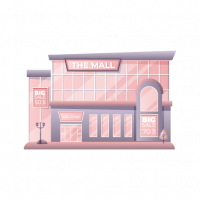Retail Media | Networks | Revolutionizing | Digital Marketing

In the fast-evolving landscape of retail and digital marketing, Retail Media Networks (RMNs) have emerged as a game-changer — especially in the context of mall advertising. Once dominated by static displays, banners, and food court posters, malls are now becoming highly digitized, data-driven spaces thanks to the rise of RMNs. This shift is redefining how brands engage with shoppers, creating dynamic and measurable advertising opportunities that were previously unimaginable.
What Are Retail Media Networks?
Retail Media Networks are digital advertising platforms
operated by retailers or mall owners that allow brands to promote products
across various customer touchpoints — both online and in physical stores.
Originally popularized by ecommerce giants like Amazon and Walmart, RMNs are
now extending into brick-and-mortar environments, particularly shopping
malls.
These networks leverage first-party data from loyalty
programs, purchase histories, and foot traffic analytics to offer
hyper-targeted advertising in the real world. From digital signage and
interactive kiosks to mobile integrations, RMNs are bringing the precision of
online ads into offline spaces.
The Digital Makeover of Mall Advertising
Mall advertising used to be static and generalized — a
one-size-fits-all approach. Retail Media Networks have disrupted that model in
several key ways:
1. Dynamic, Real-Time Content
Digital displays powered by RMNs can change content in
real-time based on:
- Time
of day
- Foot
traffic levels
- Demographics
- Weather
- Inventory
availability
This allows brands to display timely, relevant messages that
increase engagement and drive in-store purchases.
2. Data-Driven Targeting
By leveraging shopper data, RMNs can target ads more
precisely. For example, a beauty brand might target visitors who have
previously purchased skincare products or browsed beauty-related content on the
mall’s app.
3. Measurement and ROI Tracking
One of the biggest drawbacks of traditional mall advertising
was the inability to measure effectiveness. Retail Media Networks solve this by
offering:
- Impression
counts
- Click-through
rates (via mobile integrations)
- Conversion
tracking
- Attribution
models tied to in-store purchases
Brands can now track performance and optimize campaigns just
like they would with digital ads.
4. Seamless Omnichannel Integration
Retail Media Networks create a bridge between online and
offline. A shopper who browses a product online might see a follow-up ad when
walking through the mall, reinforcing the message and nudging them toward a
purchase. This omnichannel strategy boosts both brand recall and
conversion rates.
Benefits for Brands and Retailers
The rise of RMNs in malls isn’t just a win for advertisers —
it’s a boon for mall owners and retailers too.
For Brands:
- Greater
control over messaging
- Higher
ROI through data-driven campaigns
- Enhanced
shopper engagement
For Malls and Retailers:
- New
revenue streams from ad placements
- Improved
shopper experiences
- Increased
foot traffic and dwell time
Real-World Examples
Leading mall operators like Simon Property Group and
Brookfield Properties are already investing heavily in RMNs. They’re deploying digital
out-of-home (DOOH) solutions, partnering with ad tech companies, and
building internal capabilities to offer brands more sophisticated advertising
options.
Even smaller regional malls are following suit by
integrating beacon technology, mobile apps, and personalized offers into the
shopper journey — all powered by the retail media ecosystem.
The Future of Mall Advertising
As consumer expectations evolve and privacy
regulations tighten, the value of first-party data and contextual
advertising will only grow. Retail Media Networks are uniquely positioned to
capitalize on this trend, turning malls into intelligent, monetized media hubs.
In the future, expect to see:
- AI-driven
ad personalization
- Voice-activated
displays
- Augmented
reality integrations
- Real-time
bidding for in-mall ad space
Conclusion
Retail Media Networks are not just changing how malls
advertise — they’re redefining what malls are. No longer just physical
spaces for shopping, malls are becoming immersive, interactive media
environments. For brands, this means unprecedented access to consumers at
the point of purchase. For shoppers, it means more relevant, engaging
experiences.
In this new era, the fusion of media, data, and physical
retail is opening a powerful frontier — and those who adapt early will reap the
biggest rewards.
Elyts Advertising and Branding Solutions | www.elyts.in (India) | www.elyts.agency (UAE)






















Leave a Comment